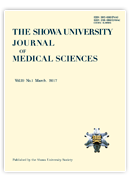Volume 29, Issue 1
Displaying 1-11 of 11 articles from this issue
- |<
- <
- 1
- >
- >|
Original
-
2017 Volume 29 Issue 1 Pages 1-7
Published: 2017
Released on J-STAGE: July 26, 2017
Download PDF (579K) -
2017 Volume 29 Issue 1 Pages 9-15
Published: 2017
Released on J-STAGE: July 26, 2017
Download PDF (264K) -
2017 Volume 29 Issue 1 Pages 17-26
Published: 2017
Released on J-STAGE: July 26, 2017
Download PDF (468K) -
2017 Volume 29 Issue 1 Pages 27-36
Published: 2017
Released on J-STAGE: July 26, 2017
Download PDF (238K) -
2017 Volume 29 Issue 1 Pages 37-50
Published: 2017
Released on J-STAGE: July 26, 2017
Download PDF (985K) -
2017 Volume 29 Issue 1 Pages 51-67
Published: 2017
Released on J-STAGE: July 26, 2017
Download PDF (1249K) -
2017 Volume 29 Issue 1 Pages 69-77
Published: 2017
Released on J-STAGE: July 26, 2017
Download PDF (434K) -
2017 Volume 29 Issue 1 Pages 79-86
Published: 2017
Released on J-STAGE: July 26, 2017
Download PDF (360K) -
2017 Volume 29 Issue 1 Pages 87-94
Published: 2017
Released on J-STAGE: July 26, 2017
Download PDF (358K)
Transactions of the Showa University Society: the 333rd Meeting
-
2017 Volume 29 Issue 1 Pages 95-100
Published: 2017
Released on J-STAGE: July 26, 2017
Download PDF (249K)
Transactions of the Showa University Society: the 334th Meeting
-
2017 Volume 29 Issue 1 Pages 101-104
Published: 2017
Released on J-STAGE: July 26, 2017
Download PDF (232K)
- |<
- <
- 1
- >
- >|
